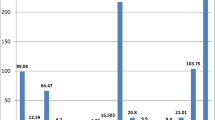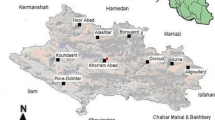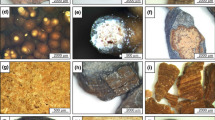Abstract
Monitoring of body burden of toxic elements is usually based on analysis of concentration of particular elements in blood, urine and/or hair. Analysis of these matrices, however, predominantly reflects short- or medium-term exposure to trace elements or pollutants. In this work, urinary stones were investigated as a matrix for monitoring long-term exposure to toxic and essential elements. A total of 431 samples of urinary calculi were subjected to mineralogical and elemental analysis by infrared spectroscopy and inductively coupled plasma mass spectrometry. The effect of mineralogical composition of the stones and other parameters such as sex, age and geographical location on contents of trace and minor elements is presented. Our results demonstrate the applicability of such approach and confirm that the analysis of urinary calculi can be helpful in providing complementary information on human exposure to trace metals and their excretion. Analysis of whewellite stones (calcium oxalate monohydrate) with content of phosphorus <0.6 % has been proved to be a promising tool for biomonitoring of trace and minor elements.


Similar content being viewed by others
References
Abboud, I. A. (2008a). Analyzing correlation coefficients of the concentrations of trace elements in urinary stones. Jordan Journal of Earth and Environmental Sciences, 1(2), 73–80.
Abboud, I. A. (2008b). Concentration effect of trace metals in Jordanian patients of urinary calculi. Environmental Geochemistry and Health, 30(1), 11–20.
Abboud, I. A. (2008c). Mineralogy and chemistry of urinary stones: Patients from north Jordan. Environmental Geochemistry and Health, 30(5), 445–463.
Atakan, I. H., Kaplan, M., Seren, G., Aktoz, T., Gul, H., & Inci, O. (2007). Serum, urinary and stone zinc, iron, magnesium and copper levels in idiopathic calcium oxalate stone patients. International Urology and Nephrology, 39(2), 351–356.
Batáriová, A., Spěváčková, V., Beneš, B., Čejchanová, M., Šmíd, J., & Černá, M. (2006). Blood and urine levels of Pb, Cd and Hg in the general population of the Czech Republic and proposed reference values. International Journal of Hygiene and Environmental Health, 209(4), 359–366.
Bazin, D., Chevallier, P., Matzen, G., Jungers, P., & Daudon, M. (2007). Heavy elements in urinary stones. Urological Research, 35(4), 179–184.
Bazin, D., Daudon, M., Combes, C., & Rey, C. (2012). Characterization and some physicochemical aspects of pathological microcalcifications. Chemical Reviews, 112(10), 5092–5120.
Beneš, B., Spěváčková, V., Šmíd, J., Čejchanová, M., Kaplanová, E., Černá, M., et al. (2002). Determination of normal concentration levels of Cd, Pb, Hg, Cu, Zn and Se in urine of the population in the Czech Republic. Central European Journal of Public Health, 10(1–2), 3–5.
Burgher, A., Beman, M., Holtzman, J. L., & Monga, M. (2004). Progression of nephrolithiasis: Long-term outcomes with observation of asymptomatic calculi. Journal of Endourology, 18(6), 534–539.
Carpentier, X., Bazin, D., Combes, C., Mazouyes, A., Rouziere, S., Albouy, P. A., et al. (2011). High Zn content of Randall’s plaque: A mu-X-ray fluorescence investigation. Journal of Trace Elements in Medicine and Biology, 25(3), 160–165.
Čejchanová, M., Wranová, K., Spěváčková, V., Krsková, A., Šmíd, J., & Černa, M. (2012). Human bio-monitoring study—toxic elements in blood of women. Central European Journal of Public Health, 20(2), 139–143.
Černá, M., Krsková, A., Čejchanová, M., & Spěváčková, V. (2012). Human biomonitoring in the Czech Republic: An overview. International Journal of Hygiene and Environmental Health, 215(2), 109–119.
Chaudhri, M. A., Watling, J., & Khan, F. A. (2007). Spatial distribution of major and trace elements in bladder and kidney stones. Journal of Radioanalytical and Nuclear Chemistry, 271(3), 713–720.
Daudon, M., Dore, J. C., Jungers, P., & Lacour, B. (2004). Changes in stone composition according to age and gender of patients: a multivariate epidemiological approach. Urological Research, 32(3), 241–247.
Durak, I., Kilic, Z., Sahin, A., & Akpoyraz, M. (1992). Analysis of calcium, iron, copper and zinc contents of nucleus and crust parts of urinary calculi. Urological Research, 20(1), 23–26.
Esteban, M., & Castano, A. (2009). Non-invasive matrices in human biomonitoring: A review. [Review]. Environment International, 35(2), 438–449.
Giannossi, M. L., Summa, V., & Mongelli, G. (2013). Trace element investigations in urinary stones: A preliminary pilot case in Basilicata (Southern Italy). Journal of Trace Elements in Medicine and Biology, 27(2), 91–97.
Glowacki, L. S., Beecroft, M. L., Cook, R. J., Pahl, D., & Churchill, D. N. (1992). The natural history of asymptomatic urolithiasis. Journal of Urology, 147(2), 319–321.
Hedayati, S. S., Minhajuddin, A. T., Ijaz, A., Moe, O. W., Elsayed, E. F., Reilly, R. F., et al. (2012). Association of urinary sodium/potassium ratio with blood pressure: Sex and racial differences. Clinical Journal of the American Society of Nephrology, 7(2), 315–322.
Horbarth, K., Koeberl, C., & Hofbauer, J. (1993). Rare-earth elements in urinary calculi. Urological Research, 21(4), 261–264.
Hothorn, T., Bretz, F., & Westfall, P. (2008). Simultaneous inference in general parametric models. Biometrical Journal, 50(3), 346–363.
Kang, H. W., Lee, S. K., Kim, W. T., Kim, Y. J., Yun, S. J., Lee, S. C., et al. (2013). Natural history of asymptomatic renal stones and prediction of stone related events. Journal of Urology, 189(5), 1740–1746.
Kuta, J., Machát, J., Benová, D., Červenka, R., & Kořistková, T. (2012). Urinary calculi—atypical source of information on mercury in human biomonitoring. Central European Journal of Chemistry, 10(5), 1475–1483.
Kuta, J., Machát, J., Benová, D., Červenka, R., Zeman, J., & Martinec, P. (2013). Association of minor and trace elements with mineralogical constituents of urinary stones: A hard nut to crack in existing studies of urolithiasis. Environmental Geochemistry and Health, 35(4), 511–522.
Moroz, T. N., Palchik, N. A., & Dar’in, A. V. (2009). Microelemental and mineral compositions of pathogenic biomineral concrements: SRXFA, X-ray powder diffraction and vibrational spectroscopy data. Nuclear Instruments and Methods in Physics Research Section a-Accelerators Spectrometers Detectors and Associated Equipment, 603(1–2), 141–143.
Perk, H., Serel, T. A., Kosar, A., Deniz, N., & Sayin, A. (2002). Analysis of the trace element contents of inner nucleus and outer crust parts of urinary calculi. Urologia Internationalis, 68(4), 286–290.
Pichette, V., Bonnardeaux, A., Cardinal, J., Houde, M., Nolin, L., Boucher, A., et al. (1997). Ammonium acid urate crystal formation in adult North American stone-formers. American Journal of Kidney Diseases, 30(2), 237–242.
Pineda-Vargas, C. A., Rodgers, A. L., & Eisa, M. E. (2004). Nuclear microscopy of human kidney stones, comparison between two population groups. Radiation Physics and Chemistry, 71(3–4), 947–950.
Pineda-Vargas, C. A., Eisa, M. E. M., & Rodgers, A. L. (2009). Characterization of human kidney stones using micro-PIXE and RBS: A comparative study between two different populations. Applied Radiation and Isotopes, 67(3), 464–469.
Puklová, V., Batáriová, A., Černá, M., Kotlík, B., Kratzer, K., Melicherčík, J., et al. (2005). Cadmium exposure pathways in the Czech urban population. Central European Journal of Public Health, 13(1), 11–19.
Rambousková, J., Krsková, A., Slaviková, M., Čejchanová, M., Wranová, K., Procházka, B., et al. (2013). Trace elements in the blood of institutionalized elderly in the Czech Republic. Archives of Gerontology and Geriatrics, 56(2), 389–394.
Rambousková, J., Krsková, A., Slavíková, M., Čejchanová, M., & Černá, M. (2014). Blood levels of lead, cadmium, and mercury in the elderly living in institutionalized care in the Czech Republic. Experimental Gerontology, 58, 8–13.
Scales, C. D., Smith, A. C., Hanley, J. M., Saigal, C. S., & Urologic Dis Amer, P. (2012). Prevalence of kidney stones in the United States. European Urology, 62(1), 160–165.
Slojewski, M. (2011). Major and trace elements in lithogenesis. Central European Journal of Urology, 64(2), 58–61.
Slojewski, M., Czerny, B., Safranow, K., Drozdzik, M., Pawlik, A., Jakubowska, K., et al. (2009). Does smoking have any effect on urinary stone composition and the distribution of trace elements in urine and stones? Urological Research, 37(6), 317–322.
Slojewski, M., Czerny, B., Safranow, K., Jakubowska, K., Olszewska, M., Pawlik, A., et al. (2010). Microelements in stones, urine, and hair of stone formers: A new key to the puzzle of lithogenesis? Biological Trace Element Research, 137(3), 301–316.
Spěváčková, V., Krsková, A., Čejchanová, M., Wranová, K., Šmíd, J., & Černá, M. (2011). Biological monitoring in the Czech Republic—trace elements and occupationally unexposed population. Klinicka Biochemie a Metabolismus, 19(2), 101–107.
Wandt, M. A. E., & Underhill, L. G. (1988). Covariance biplot analysis of trace-element concentrations in urinary stones. British Journal of Urology, 61(6), 474–481.
Acknowledgments
This research was supported by the Ministry of Education of the Czech Republic (LM2011028 and LO1214) and co-funded by the European Social Fund and the state budget of the Czech Republic. We also want to thank Ondřej Sáňka (RECETOX, Masaryk University) for creating the map for our paper.
Author information
Authors and Affiliations
Corresponding author
Electronic supplementary material
Below is the link to the electronic supplementary material.
Rights and permissions
About this article
Cite this article
Kuta, J., Smetanová, S., Benová, D. et al. Urinary stones as a novel matrix for human biomonitoring of toxic and essential elements. Environ Geochem Health 38, 133–143 (2016). https://doi.org/10.1007/s10653-015-9691-2
Received:
Accepted:
Published:
Issue Date:
DOI: https://doi.org/10.1007/s10653-015-9691-2




